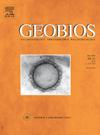New fossil Asian palm civets (Carnivora, Viverridae) from the Siwaliks of Pakistan
IF 1.6
4区 地球科学
Q2 PALEONTOLOGY
引用次数: 0
Abstract
The Neogene fossil record of Asian palm civets (Viverridae of the subfamilies Paradoxurinae and Hemigalinae) is extremely rare and scarce, and until now mostly restricted to Africa. Here we describe two new species of extinct Asian palm civets from the Siwaliks of Pakistan. Two isolated lower carnassial teeth were collected from Upper Miocene deposits of the Dhok Pathan Formation in the vicinity of Hasnot, Jhelum, and from Middle Miocene deposits of the Chinji Formation in Kanhatti, Khushab, Punjab province of Pakistan. The Hasnot specimen belongs to the genus Mioparadoxurus, previously reported from Haritalyangar, a Late Miocene locality of northern India. The unique morphology of the specimen (e.g., larger and stouter paraconid, high-crowned talonid with three cuspids, talonid larger than trigonid, undivided paraconid and hypoconulid), in addition to its small size, allows us to attribute it to the new species Mioparadoxurus micros nov. sp. This occurrence extends the geographical range of the genus into Pakistan. Mioparadoxurus is closely related to the extant palm civet Paradoxurus and thus constitutes one of the rare fossil members of the subfamily Paradoxurinae in Asia. The Kanhatti specimen is also unique in its morphology. It is small, has low hypoconid cusplets, and a unique combination of characters of its talonid cuspids. We attribute this lower carnassial to the new genus and species Parakichechia sikandari nov. gen., nov. sp., which shows similarities to the extinct African genus Kichechia, placed in either the subfamily Paradoxurinae or Hemigalinae. Although the material of these two new species does not permit full investigation of phylogenetic relationships between fossil and extant palm civets, it highlights the importance of South Asian Neogene deposits for understanding the evolutionary history of modern Asian faunas.
巴基斯坦西瓦利克地区亚洲棕榈果子狸新化石(食肉目,果子狸科)
亚洲棕榈果子狸新近纪的化石记录极其罕见和稀少,直到现在主要局限于非洲。在这里,我们描述了两个新物种灭绝的亚洲棕榈果子狸从巴基斯坦的西瓦里克。在Jhelum Hasnot附近的上中新世Dhok Pathan组沉积物和巴基斯坦旁遮普省Khushab Kanhatti的中中新世Chinji组沉积物中收集了两个孤立的下卡尼萨尔牙齿。Hasnot标本属于Mioparadoxurus属,以前在印度北部晚中新世的Haritalyangar地区报道过。该标本的独特形态(例如,较大且较粗的副纲,有三个尖的高冠talonid,比三角体大的talonid,未分的副纲和下圆锥),加上它的小尺寸,使我们能够将其归为新物种Mioparadoxurus micros nov. sp。这一发现将该属的地理范围扩展到巴基斯坦。Mioparadoxurus与现存的棕榈果子狸有密切的亲缘关系,是亚洲罕见的果子狸亚科化石成员之一。坎哈提标本在形态上也很独特。它体型小,具有低的下圆锥齿,并具有独特的爪状齿的组合特征。我们将这一较低的食性归因于新属和新种Parakichechia sikandari nov. gen., nov. sp.,它与已灭绝的非洲属Kichechia相似,被置于Paradoxurinae亚科或Hemigalinae。虽然这两个新种的材料不能全面研究化石和现存棕榈果子狸之间的系统发育关系,但它强调了南亚新近纪沉积物对理解现代亚洲动物群进化史的重要性。
本文章由计算机程序翻译,如有差异,请以英文原文为准。
求助全文
约1分钟内获得全文
求助全文
来源期刊

Geobios
地学-古生物学
CiteScore
3.30
自引率
6.20%
发文量
28
审稿时长
6-12 weeks
期刊介绍:
Geobios publishes bimonthly in English original peer-reviewed articles of international interest in any area of paleontology, paleobiology, paleoecology, paleobiogeography, (bio)stratigraphy and biogeochemistry. All taxonomic groups are treated, including microfossils, invertebrates, plants, vertebrates and ichnofossils.
Geobios welcomes descriptive papers based on original material (e.g. large Systematic Paleontology works), as well as more analytically and/or methodologically oriented papers, provided they offer strong and significant biochronological/biostratigraphical, paleobiogeographical, paleobiological and/or phylogenetic new insights and perspectices. A high priority level is given to synchronic and/or diachronic studies based on multi- or inter-disciplinary approaches mixing various fields of Earth and Life Sciences. Works based on extant data are also considered, provided they offer significant insights into geological-time studies.
 求助内容:
求助内容: 应助结果提醒方式:
应助结果提醒方式:


